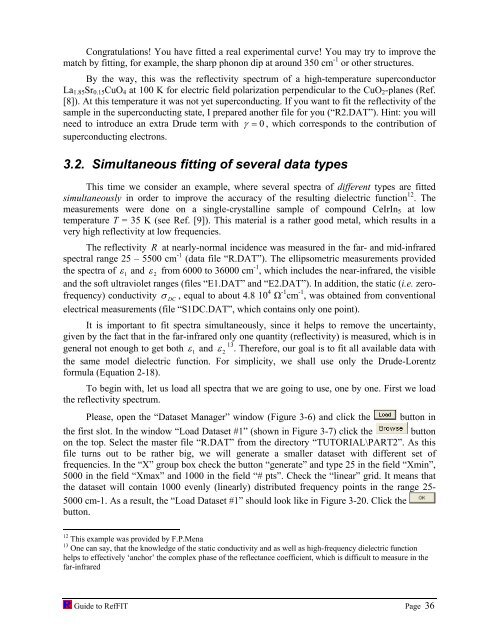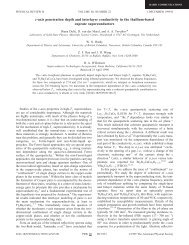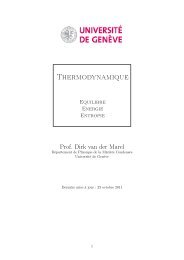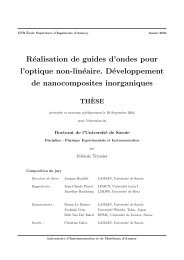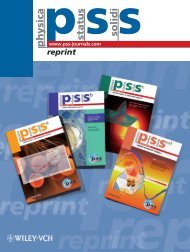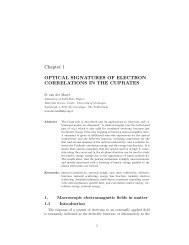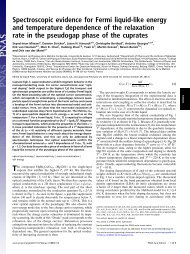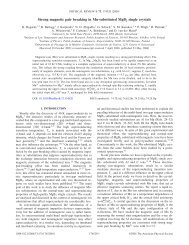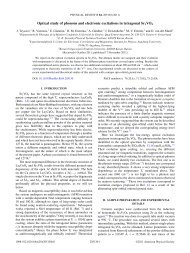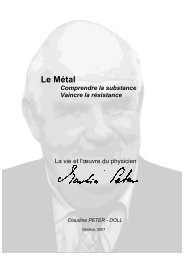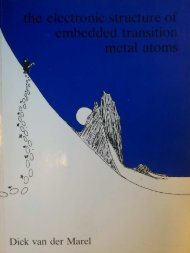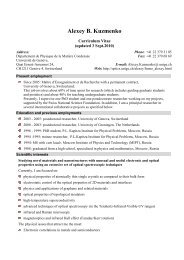software to fit optical spectra - Quantum Materials Group
software to fit optical spectra - Quantum Materials Group
software to fit optical spectra - Quantum Materials Group
You also want an ePaper? Increase the reach of your titles
YUMPU automatically turns print PDFs into web optimized ePapers that Google loves.
Congratulations! You have <strong>fit</strong>ted a real experimental curve! You may try <strong>to</strong> improve the<br />
match by <strong>fit</strong>ting, for example, the sharp phonon dip at around 350 cm -1 or other structures.<br />
By the way, this was the reflectivity spectrum of a high-temperature superconduc<strong>to</strong>r<br />
La1.85Sr0.15CuO4 at 100 K for electric field polarization perpendicular <strong>to</strong> the CuO2-planes (Ref.<br />
[8]). At this temperature it was not yet superconducting. If you want <strong>to</strong> <strong>fit</strong> the reflectivity of the<br />
sample in the superconducting state, I prepared another file for you (“R2.DAT”). Hint: you will<br />
need <strong>to</strong> introduce an extra Drude term with γ = 0 , which corresponds <strong>to</strong> the contribution of<br />
superconducting electrons.<br />
3.2. Simultaneous <strong>fit</strong>ting of several data types<br />
This time we consider an example, where several <strong>spectra</strong> of different types are <strong>fit</strong>ted<br />
simultaneously in order <strong>to</strong> improve the accuracy of the resulting dielectric function 12 . The<br />
measurements were done on a single-crystalline sample of compound CeIrIn5 at low<br />
temperature T = 35 K (see Ref. [9]). This material is a rather good metal, which results in a<br />
very high reflectivity at low frequencies.<br />
The reflectivity R at nearly-normal incidence was measured in the far- and mid-infrared<br />
<strong>spectra</strong>l range 25 – 5500 cm -1 (data file “R.DAT”). The ellipsometric measurements provided<br />
the <strong>spectra</strong> of ε 1 and ε 2 from 6000 <strong>to</strong> 36000 cm -1 , which includes the near-infrared, the visible<br />
and the soft ultraviolet ranges (files “E1.DAT” and “E2.DAT”). In addition, the static (i.e. zerofrequency)<br />
conductivity σ DC , equal <strong>to</strong> about 4.8 10 4 Ω -1 cm -1 , was obtained from conventional<br />
electrical measurements (file “S1DC.DAT”, which contains only one point).<br />
It is important <strong>to</strong> <strong>fit</strong> <strong>spectra</strong> simultaneously, since it helps <strong>to</strong> remove the uncertainty,<br />
given by the fact that in the far-infrared only one quantity (reflectivity) is measured, which is in<br />
general not enough <strong>to</strong> get both ε 1 and ε 2<br />
13 . Therefore, our goal is <strong>to</strong> <strong>fit</strong> all available data with<br />
the same model dielectric function. For simplicity, we shall use only the Drude-Lorentz<br />
formula (Equation 2-18).<br />
To begin with, let us load all <strong>spectra</strong> that we are going <strong>to</strong> use, one by one. First we load<br />
the reflectivity spectrum.<br />
Please, open the “Dataset Manager” window (Figure 3-6) and click the but<strong>to</strong>n in<br />
the first slot. In the window “Load Dataset #1” (shown in Figure 3-7) click the but<strong>to</strong>n<br />
on the <strong>to</strong>p. Select the master file “R.DAT” from the direc<strong>to</strong>ry “TUTORIAL\PART2”. As this<br />
file turns out <strong>to</strong> be rather big, we will generate a smaller dataset with different set of<br />
frequencies. In the “X” group box check the but<strong>to</strong>n “generate” and type 25 in the field “Xmin”,<br />
5000 in the field “Xmax” and 1000 in the field “# pts”. Check the “linear” grid. It means that<br />
the dataset will contain 1000 evenly (linearly) distributed frequency points in the range 25-<br />
5000 cm-1. As a result, the “Load Dataset #1” should look like in Figure 3-20. Click the<br />
but<strong>to</strong>n.<br />
12 This example was provided by F.P.Mena<br />
13 One can say, that the knowledge of the static conductivity and as well as high-frequency dielectric function<br />
helps <strong>to</strong> effectively ‘anchor’ the complex phase of the reflectance coefficient, which is difficult <strong>to</strong> measure in the<br />
far-infrared<br />
Guide <strong>to</strong> RefFIT Page 36


